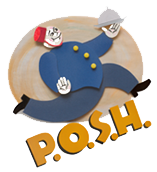Antique Queen Victoria 1897 Diamond Jubilee Jug
Antique Queen Victoria 1897 Diamond Jubilee Jug
SOLD
Produced more than 125 years ago as a piece of commemorative tableware celebrating the Diamond Jubilee of Queen Victoria, this decorative stoneware pitcher or jug is a sweet reminder of family and community celebrations from a long bygone era.
At center a hand-colored transferware image of Victoria emerges in boldly tinted hues of red, blue and yellow. From one of England's classic Staffordshire potter's, the queen's likeness is accented by two small insets containing the St. Edward Coronation Crown and the monarch's initials styled VR.
The cheerful central design is underscored by the Royal Standard and Union Jack, along with the name VICTORIA. On the reverse a withering rose and thistle seem to fade away. A subtle band of gold encircles upper and lower bas relief sections, offering a decorative distinction from the main body of the jug, while dedications celebrate:
As an early incarnation of royal memorabilia designed to be affordable for everyday Britons, this well-loved Diamond Jubilee Jug promises to bring its sweet personality to your collection of royal family or English pottery treasures.
Strictly one-of-a-kind and subject to prior sale. In fair original antique condition with significant staining, crazing and wear as shown in the alternate images. 11"H x 4.5" in diameter.
Learn More About Queen Victoria
Queen Victoria was the monarch of the United Kingdom of Great Britain and Ireland from June 20, 1837 until her death on January 22, 1901. From May 1, 1876, she used the additional title of Empress of India.
Victoria was born on May 24, 1819 and was the daughter of Prince Edward, the fourth son of King George III. In a twist of fate, both her father and the King died in 1820, and Victoria was raised under close supervision by her very strict German-born mother Princess Victoria of Saxe-Coburg-Saalfeld. On June 20, 1837, Victoria's uncle King William IV died at the age of 71, and at the very young age of 18, Victoria became Queen. In her diary she wrote, "I was awoke at 6 o'clock by Mamma, who told me the Archbishop of Canterbury and Lord Conyngham were here and wished to see me. I got out of bed and went into my sitting-room (only in my dressing gown) and alone, and saw them. Lord Conyngham then acquainted me that my poor Uncle, the King, was no more, and had expired at 12 minutes past 2 this morning, and consequently that I am Queen."
The United Kingdom was already an established constitutional monarchy, in which the Sovereign held relatively few direct political powers. Privately, Victoria attempted to influence government policy and ministerial appointments. Publicly, she became a national icon, and was identified with strict standards of personal morality.
Victoria married her first cousin, Prince Albert of Saxe-Coburg and Gotha, in 1840. By all accounts a happy union, their nine children married into royal and noble families across the continent, tying them together and earning Victoria the nickname "the grandmother of Europe".
After Albert's early death in 1861, Victoria plunged into deep mourning for the remainder of her life, choosing to wear black and having a special crown fashioned that would allow her widow's cap (head veil) to remain in place for royal engagements.
The 60th anniversary of her reign, her Diamond Jubilee, was a time of joyous public celebration on June 22, 1897. Queen Victoria had surpassed her grandfather King George III as the longest-reigning British monarch on 23 September 1896, an event she marked privately at Balmoral Castle. Writing in her journal, she reflected "People wished to make all sorts of demonstrations, which I asked them not to do until I had completed the sixty years next June." The Diamond Jubilee became a historic opportunity to celebrate Victoria's status as longest-reigning monarch, in addition to marking 60 years on the throne.
On the anniversary date of her accession, 78 year-old Victoria once again reflected in her journal: "This eventful day, 1897 has opened, and I pray God to help and protect me as He has hitherto done these sixty long eventful years! I feel sad at the new losses I have sustained... God will surely help me on! How well I remember this day sixty years ago when I was called from my bed by dear Mama to receive the news of my accession!"
Until the record-setting service of Elizabeth II, Queen Victoria's reign of 63 years and seven months was the longest of any other British monarch and the longest of any female monarch in history. Still referred to today as the Victorian era, it was a period of vast industrial, cultural, political, scientific, and military change within the United Kingdom.
Learn More about Coronation Memorabilia
As a means to commemorate historic events - including coronations; silver, golden and diamond jubilees; royal weddings and royal visits to distant lands - artisans and craftspeople were commissioned to create beautiful pieces of memorabilia. Highly collectable, they are much more than mementos of an event long past. They are lovely pieces created to capture the spirit of their time as much as they capture our imaginations today.








